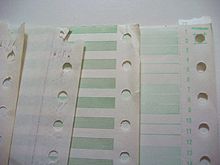- Continuous stationery
-
Continuous stationery (UK) or Continuous form paper (USA) is paper, which is designed for use with dot-matrix printers and line printers. Other names for continuous stationery include fan-fold paper, sprocket feed paper, burst paper, tractor-feed paper, and pin feed paper. It can be woodfree uncoated paper (single ply) or carbonless copy paper (multi ply).
Contents
Shape and Form
Continuous paper is perforated transversely at regular intervals with a line of small slits which form a tear edge that defines the top and bottom of each page. When unfolded into a flat continuous sheet, this slit perforation closes up to allow the printer to print across the perforated edge without stopping or jamming.
The paper is fed vertically through the printer, with the edges of the continuous paper forming the left and right edges of the page.
The paper is also punched longitudinally along both side edges with 5/32-inch (4 mm) diameter engagement holes at a regular 1/2-inch spacing. These holes engage with sprocket wheels or toothed belts, which push or pull the paper through the printer. The holes can either be of a serrated edge pattern (older production machinery) or with smooth plain edges (New Generation production method).
Better quality continuous paper also includes additional longitudinal slit perforations alongside the engagement holes, allowing the large holes to be torn off the printed page, allowing a general approximation to cut-sheet paper typically used in a press, typewriter, or other sheet-fed printer. File or ring binder holes can also be added to the main body of the form to allow for storage once the form has been divided in to individual sheets.
Common types
The highest grade of continuous paper uses a heavy bond weight similar to typing paper. It uses a very fine perforation of tiny pinholes, and is pre-scored along the perforations. After printing, it is folded along the scored edge to weaken the paper, and then torn off. The fine row of perforations tear off as a very smooth edge that simulates the edge quality of normal cut-sheet typing paper, without the jagged appearance of cheaper long-slit perforations.
The cheapest grade of continuous paper is commonly referred to as green bar[1] or music paper. It is a very lightweight bond, and the engagement holes cannot be removed. On one side are regularly spaced horizontal stripes of light green ink, used to help guide the eye of a person reading across many columns of printed data.
Commons sizes:
- 241mm x 279mm (9.5in x 11in)
- 381mm x 279mm (15in x 11in)
Separation and Binding
A decollator separated multi-part continuous paper into separate stacks of one-part continuous paper and removed the carbon paper.
A burster is a machine that separates one-part continuous paper into separate, individual sheets along the perforations. A burster was typically used with printed continuous-fed paper used in mass-mail advertising. Bursting is done by firmly gripping the second-to-last sheet, and feed rollers grip the last sheet firmly and pulls it away to burst the perforation. The continuous forms then advance into the feed rollers to burst the next sheet. Bursting is often a high-speed process that allows the continuous sheets to feed in at a steady rate, with burst pages either stacked or fed into a single-sheet conveyance to the next paper processing stage. Burster equipment and paper manufactures had to generate perforation specifications so that the paper perforations reliably separated under the force of pulling the sheets apart and not tear down into the printed part of the sheet.
When used to print large continuous documents, they might not be split into separate sheets. By continuously folding two single sided printed sheets back-to-back and binding together a stack of continuous-feed paper along one of the folded edges, it is possible to flip through the stack like a book of double-sided printed pages. With this technique, the stack of papers is normally flipped top to bottom or bottom to top rather than side to side.
History
This paper type was used with tabulating machines beginning in the 1920s,[2] and its use grew with the introduction of commercial computers in the 1950s. IBM cards, preprinted, optionally numbered and pre-punched, were available as continuous form cards and were used for checks and other documents.[3] Continuous form paper became widely used and well-known to the general public in the 1980s due to the development of microcomputers and inexpensive dot-matrix consumer printers.
Continuous form paper began to disappear from the consumer market in the 1990s as desktop publishing, and WYSIWYG document generation became more popular and widespread. Consumers were willing to pay more to get a laser printer or inkjet printer that could produce near-typeset-quality documents. These printers accept standard size cut sheets (letter, legal or A4) of paper and don't require continuous form paper. Continuous form paper continues to be used in specialty commercial and industrial markets and, as of 2011, is still available from large office suppliers such as OfficeMax.
See also
Notes and References
- ^ See: Evans, Christopher (1981). The Making of the Micro: A History of the Computer. VNR. ISBN 0-442-22240-8.; the first several pages of book are replicas of green bar form
- ^ http://www.columbia.edu/acis/history/tabulator.html
- ^ IBM (1953). Principles of IBM Accounting. 224-5527-2.
- The Free Online Dictionary of Computing
External links
Categories:- Paper products
- Stationery
- Computer printers
Wikimedia Foundation. 2010.




